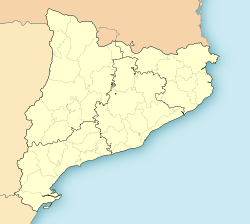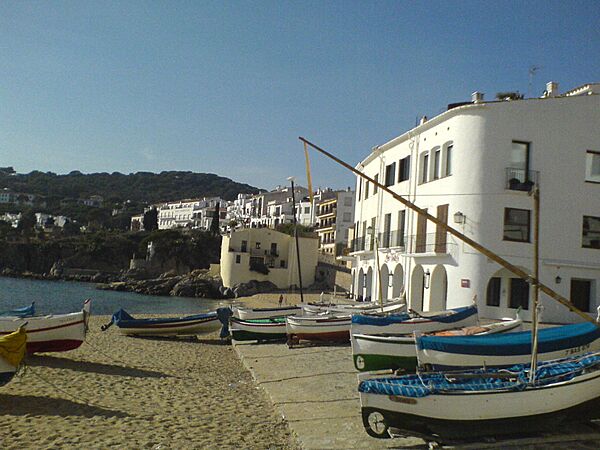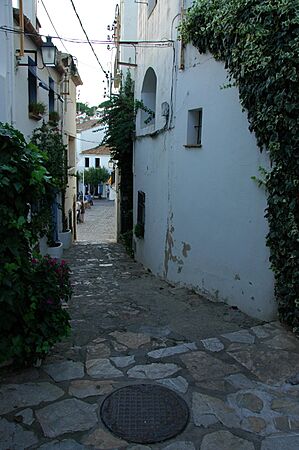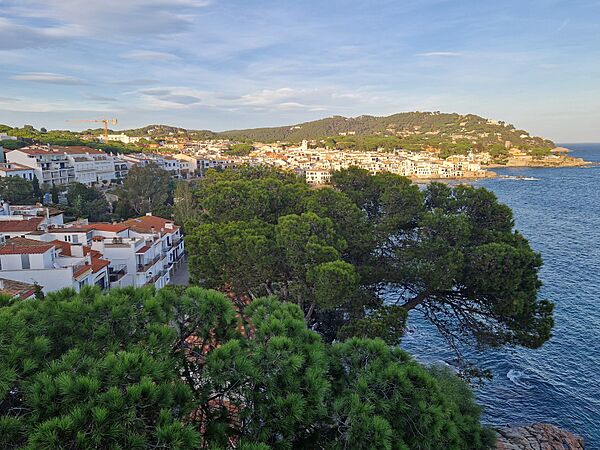Calella de Palafrugell facts for kids
Quick facts for kids
Calella de Palafrugell
|
|
|---|---|
|
Town
|
|

Calella de Palafrugell
|
|
| Country | |
| Autonomous community | |
| Province | Girona |
| Comarca | Baix Empordà |
| Municipality | Palafrugell |
| Elevation | 0 m (0 ft) |
| Time zone | UTC+1 (CET) |
| • Summer (DST) | UTC+2 (CEST) |
Calella de Palafrugell is a lovely coastal town in Spain. It's one of three towns that belong to the area of Palafrugell in the province of Girona. The other two towns are Llafranc, which is only one kilometre (0.62 mi) north, and Tamariu, about four kilometres (2.5 mi) north. These towns are all part of the beautiful Costa Brava, which is the coast of northeastern Catalonia. It's important not to confuse Calella de Palafrugell with the larger town of Calella, which is closer to Barcelona.
Calella de Palafrugell is a wonderful place to visit. Even though it gets busy in the summer, it doesn't have huge hotels or lots of mass tourism like some other places on the Costa Brava. The town has nice hotels, apartments, and some campsites a bit further from the beach. This part of the Costa Brava has become more popular and offers great restaurants and places to stay. The beaches here are very clean and have a special "Blue Flag" award.
Contents
History of Calella
Calella de Palafrugell started out as a small fishing village. Its old fishing area, called Port Bo, is very important culturally. This part of town still looks like it did a long time ago, with its traditional white buildings and porches.
You can see old stone arches, called vaults, in Port Bo. These were once used to mend fishing nets and sell fish. Today, many of them are home to restaurants. The beaches of Platja del Port de Malaspina and Platja de Portbò are right in front of these vaults. They used to be natural fishing ports and still have small fishing boats today.
Also in Port Bo is the Sa Perola Interpretation Centre. This building used to be a place where fishing nets were dyed. Now, it's a tourist office and a museum. It teaches visitors all about the local fishing history and the town's connection to the sea.
Exploring the Beaches
Calella de Palafrugell has many small coves and beaches. They are all connected by a well-made coastal path called the Cami de Ronda. This path goes along the cliffs and even through some tunnels.
- The first beach from the north is Platja del Canadell. It has a restaurant right on the sand.
- In the center of Calella, you'll find sandy coves like Platja del Port de Malaspina, Platja de Portbò, and Platja d'en Calau.
- Further along are Platgeta d'en Cosme, Platje de Port Pelegri, and Platja de Sant Roc.
- The last beach is Platja del Golfet, which is about 1.5 kilometres (0.93 mi) from the town center.
Cap Roig Gardens and Festival
Beyond Platja del Golfet is a headland called Cap Roig. Here, you'll find the beautiful Castell de Cap Roig (Cap Roig Castle). It's surrounded by huge botanical gardens filled with amazing plants. The castle is also considered a very important cultural site.
The castle was built and the gardens were created between 1929 and 1975 by Nicholas Woevodski and Dorothy Webster. Every summer, usually in July and August, the Cap Roig Festival takes place in these gardens. It's a popular music and dance festival.
Coastal Paths and Nature
The GR 92 is a very long walking path that goes along the entire Mediterranean coast of Spain. This path follows the Cami de Ronda right through Calella de Palafrugell.
- To the north of Platja del Canadell, the path goes a short distance along the coast to Llafranc. On the way, you can see the 16th-century Torre de Calella (Calella Tower).
- To the south, the path goes inland from Platja del Golfet. It goes around Cap Roig through forests of pine and cork oak trees. This path leads to the fishing village of S'Alguer and the beach at La Fosca.
Gallery
See also
 In Spanish: Calella de Palafrugell para niños
In Spanish: Calella de Palafrugell para niños









